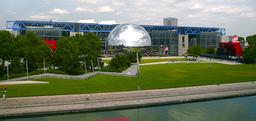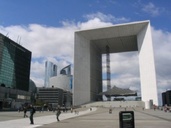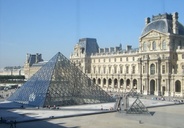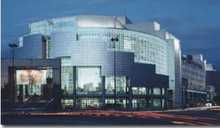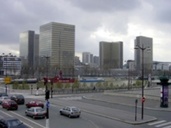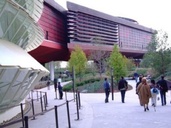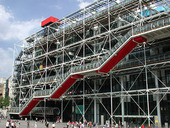
“By their fruits ye shall know them” (Matthew 7, verse 20)
Every French president likes to leave some kind of lasting legacy of their time in office. It’s as though they come to realize that the possession of abundant executive power (it is a kind of elected dictatorship in many respects) is not enough: they want to leave a permanent trace of their time in office – and because France is still a highly centralized state, with Paris the centre of cultural as well as political power, these presidential initiatives always focus on the capital. I should emphasize that these projects are financed from a specific presidential fund (which in the case of François Mitterand was extremely large) and so do not have to go through ministerial or legislative processes.
Click to enlarge images
Georges Pompidou, who died in office after only five years as president, wanted to transform Paris into a “modern” city (he was particularly enthusiastic about the motor car). During his presidency he was responsible for the art museum which bears his name, which was also related to the destruction of the Halles market. Typically, it is a modernist structure (tourists love it), bearing no relation to the buildings of the surrounding area. He was also behind the express freeway along the Seine (thereby excluding pedestrians from one of the most delightful areas of the city), and much of the worst disfiguring architectural developments of Paris were conducted under his aegis, most notably the Montparnasse tower. Fortunately he did not succeed in realizing all his projects (see my Letter from Paris-February/March 2009).
Giscard d’Estaing was behind the modernist Science Museum,
while Mitterand (president for 14 years) pushed through a number of big architectural projects which have certainly left a mark: the Grande Arche de la Defence, the pyramid at the Louvre (inaugurated exactly 20 years ago), the expensive Opera House and the astronomically expensive National Library.
Chirac, less cultivated and (perhaps) less ambitious than his predecessor, has left only the “primitive art” museum, which personally I both dislike and disapprove of, but that is for another letter.
Nicolas Sarkozy has now been in office for exactly two years, but until now there has been no indication of his ambitions in respect of big architectural projects (no one can accuse him of inaction, however – rather to the contrary he is a kind of whirlwind in day-to-day politics). In the last few weeks however, he has made his intentions much clearer, and once again they focus exclusively on the capital. What he proposes in effect is to transform Paris into a major conglomeration, and characteristically it has a strong political dimension. As I mentioned in my Letter from Paris-February/March 2009, Paris as an administrative unit is very small compared with most capital cities (London, for example). If these proposals are realized that will change for ever: a new “greater Paris” will absorb surrounding departments which contain suburban concentrations (or is it that these will absorb Paris?) Major transport networks will be established to link these to each other.
In addition a big science research centre will be expanded together with a similar social sciences research and teaching centre (this will leave the Paris university system effectively reduced to the status of a higher education institute). At a time when the whole university teaching and research community is in open revolt against the proposed government “reforms” this aspect of the project is not politically neutral. The same can be said for the main institutional implication: the new Paris will become a unitary authority. The city has been dominated by a socialist administration since 2001, with little prospect of a return to power of the government party. A recent report (concerning the whole of France), although quite separate from these propositions, suggested a number of changes for the Paris region which are in harmony with them, a report which the socialist party has denounced as politically biased (an accusation that was hotly denied by the president of the committee which produced it).
There are also a number of ambitious architectural projects for the new “greater” Paris, displayed in a big exhibition: http://www.citechaillot.fr/activite/evenements.php?id=307
Of course many things can happen before all of this comes to fruition, but given the personality of president Sarkozy, I would not bet against the realization of these proposals. One thing seems very clear however: Paris is set to be transformed in ways I personally find unattractive. There are already examples of projects for big modernist sky scrapers, one of which is at the initiative of the socialist mayor of Paris: he too, it seems, wants to “leave his mark” on the city.
http://www.dailymotion.com/video/x6wtnw_une-pyramide-porte-de-versailles_news
Julian Arloff


